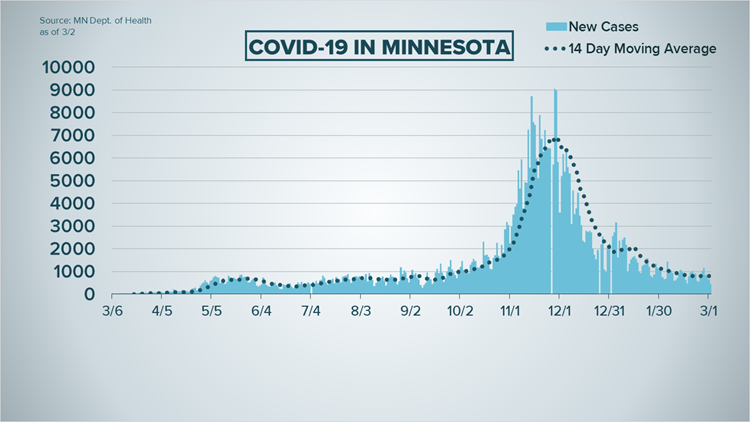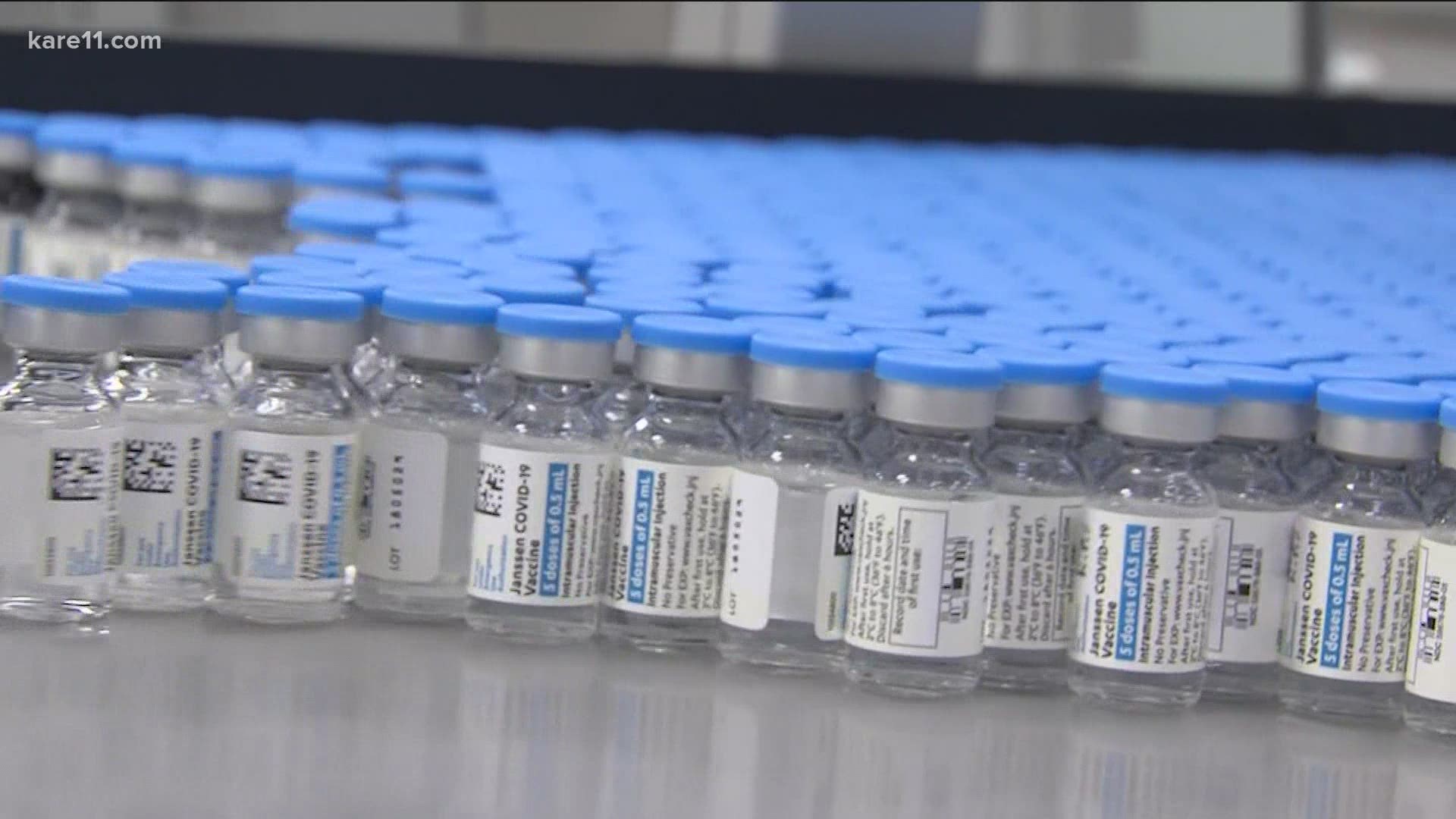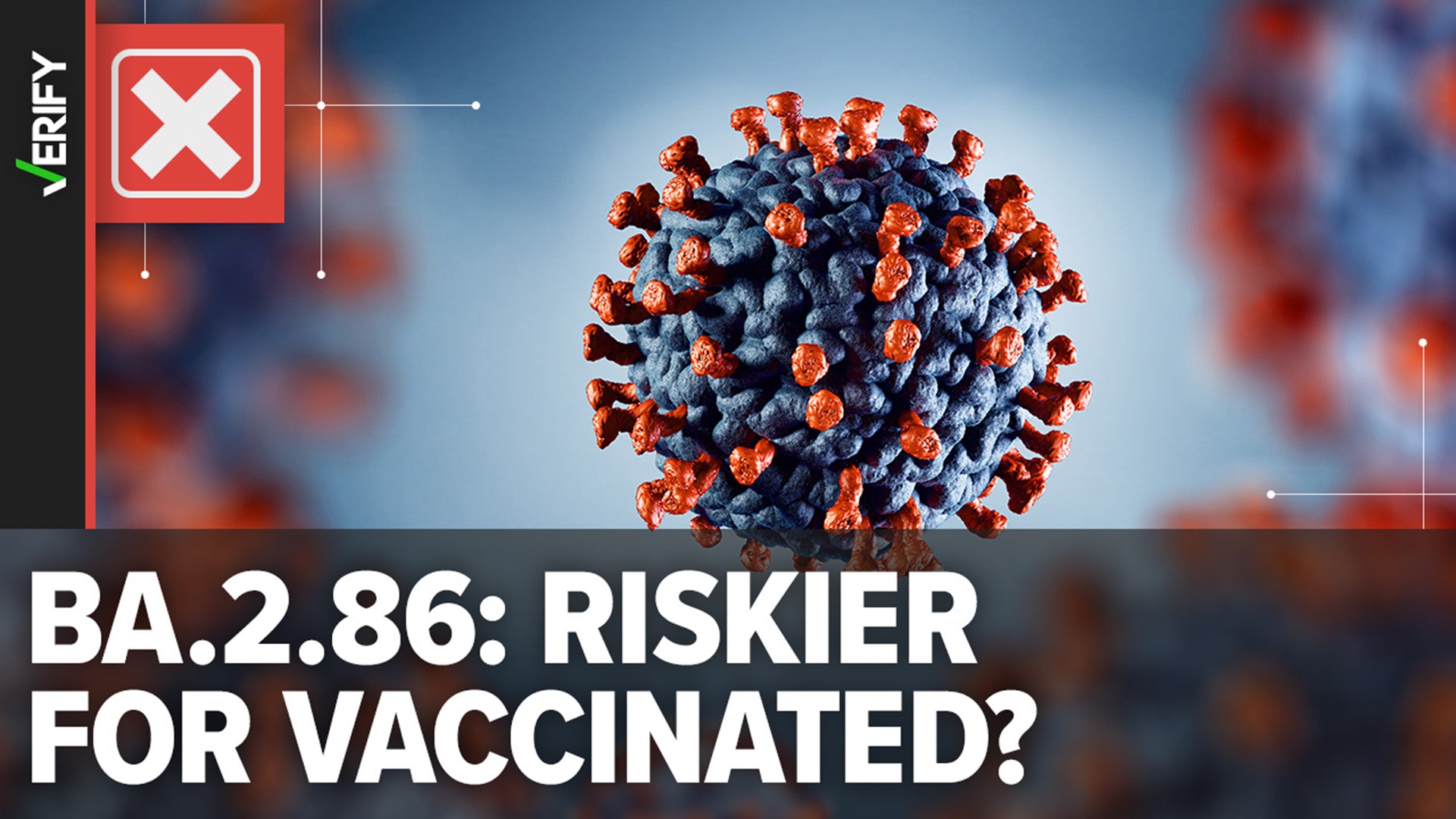ST PAUL, Minn. — Tuesday, March 2
- MDH reports 443 new COVID cases on low testing volume
- Vaccines administered Thursday, Friday exceed 127,000 doses
- Johnson & Johnson vaccine receives emergency approval
- MDH: 636 new COVID-19 cases, three deaths reported Monday
- Walz: 70% of Minnesotans ages 65-plus will be vaccinated before other groups are eligible
- Johnson & Johnson vaccine expected to arrive in Wisconsin next week
2 p.m.
Officials from the Minnesota Department of Health gave an update on the state's COVID-19 situation, which you can watch on here on KARE 11's YouTube page.
Late last month, Gov. Tim Walz released a plan for vaccination stages in Minnesota, with expanded access beginning once at least 70% of Minnesotans who are 65 and older are vaccinated. MDH Commissioner Jan Malcolm said the state expects to reach the 70% benchmark by the end of March, and that a document giving more details on the vaccination stages is now available. About 53% of Minnesota's seniors have received at least one dose of the vaccine.
Malcolm announced some updates to the state's plan for who gets vaccinated when.
- Type 1 diabetes has been added as an underlying medical condition for phase 1b tiers 3 and 4. Type 2 diabetes was already included.
- Language added for phase 1b, tier 2, which includes "People with rare conditions or disabilities that put them at high risk." Malcolm said these conditions might be too uncommon to have been listed in the CDC's or Minnesota's recommendations. She said physicians can have some flexibility in getting vaccines to people with uncommon high-risk conditions.
- Two more types of essential workers added to phase 1b, tier 3.
These changes are reflected in MDH's online documentation.
Asked if the new Johnson & Johnson vaccine could speed the vaccination process up in Minnesota, Malcolm said the timeline is a "good planning tool," but officials have "every hope" that it can be accelerated as supply increases.
Malcolm was also asked if the state has any unique distribution plans for the Johnson & Johnson vaccine due to its one-dose process and less stringent handling processes. She said MDH will evaluate the possibilities. She said it would be a good vaccine to consider for those who might find it difficult to come back for another dose, and for some other situations.
However, Malcolm emphasized that all of the authorized vaccines will be available to anyone in the state who's eligible. She said people who can get a vaccine should take the type they are offered to avoid having to "get back in line" and wait for their preferred type.
Asked about recent cases of Minnesotans getting vaccinated in South Dakota and vice versa, Malcolm said some crossover is "appropriate and necessary," like when a Minnesotan's primary care clinic is in a different state. She said a small amount of crossover likely would not make a big difference in vaccine availability.
11 a.m.
New numbers from the Minnesota Department of Health (MDH) reflect 443 additional cases of COVID-19 in the past 24-hour reporting period, along with four more deaths from the virus.
Tuesday numbers are generally the lowest of the week, as they are culled from tests done over the weekend when volume is quite low. The new COVID cases are based on results from just 10,915 tests (9,507 PCR, 1,408 antigen) processed in private and state labs. Testing volume reported at the end of the week can sometimes be four times that volume or more.
Health experts consider a positive PCR test a confirmed COVID case, while a positive antigen test is considered a probable case.
Tuesday's additions bring Minnesota's total COVID cases to 485,655 since the start of the pandemic.
Four more deaths from coronavirus brings state fatalities to 6,490. Of those deaths 4,057, or 63% of them, are linked to assisted living or long-term care facilities.

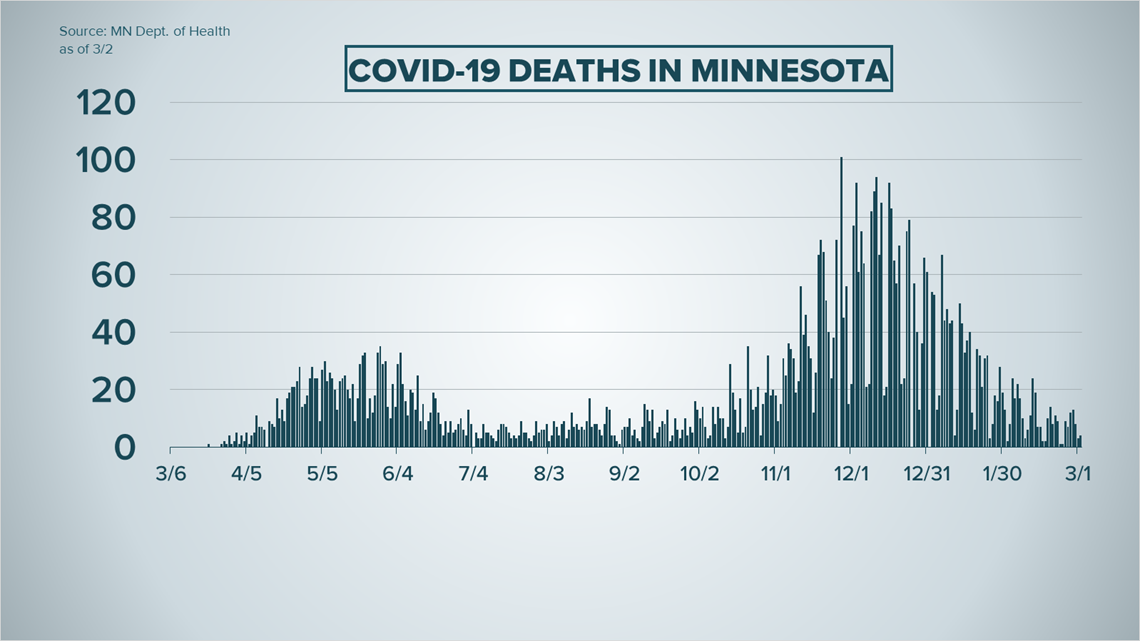
Vaccination numbers reported Tuesday are also rather low. As of Sunday, 908,590 Minnesotans have received at least one immunization, after just 6,763 people received COVID vaccine that day. That inches the percentage of Minnesotans who have had at least one shot up to 16.3%.
MDH says 472,789 people have completed the two-shot series.


The good news is that providers are exceeding a state goal to administer 90% of the vaccine supplies they receive in three days time. Currently, those providers are using 92% of their vaccine in that time.
Hospitalizations for COVID-19 are up slightly as of Monday, with 243 people being treated on an inpatient basis across Minnesota. Of those patients 57 are in ICU. The total number of hospitalizations now stands at 25,826 since the virus arrived in the state, with 5,329 requiring ICU care.

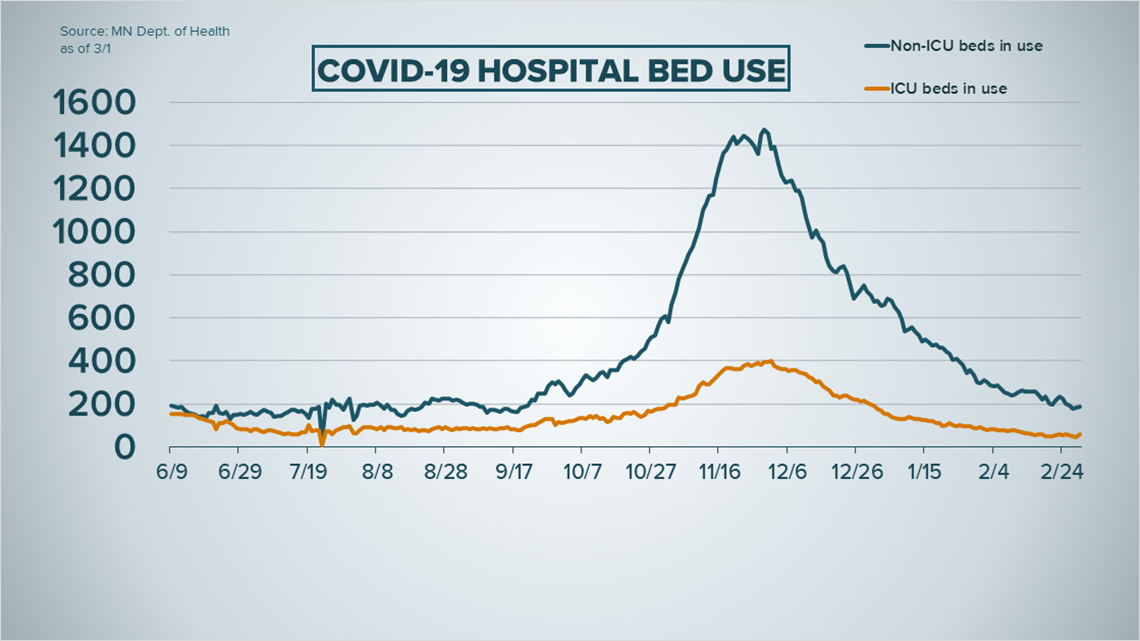
Young adults account for the two largest COVID case groupings in the state with people between 20 and 24 recording 48,334 cases and three deaths, and those between 25 and 29 numbering 43,379 cases and six deaths.
The demographic between ages 85 and 89 have suffered the most deaths from coronavirus, with 1,229 in just 6,253 diagnosed cases.
As the most populous county in the Minnesota, Hennepin County has seen the most COVID activity with 100,764 cases and 1,586 deaths, followed by Ramsey County with 43,106 cases and 801 deaths, Dakota County with 36,297 cases and 390 deaths, and Anoka County with 33,293 cases and 385 deaths.
MDH says 472,470 people who at one time tested positive for the virus no longer require isolation.

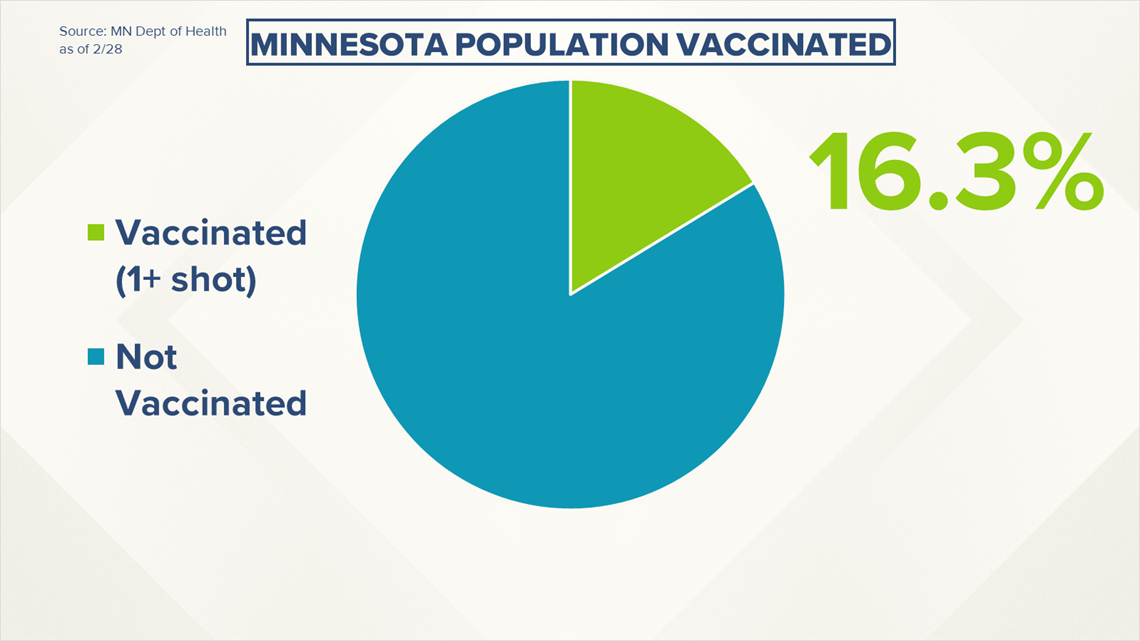
Monday, March 1
4:30 p.m.
The Wisconsin Department of Health Services says the state is expected to receive about 47,000 doses of the newly approved single-dose Johnson & Johnson COVID-19 vaccine next week.
“The Johnson & Johnson vaccine is going to be a game changer for our statewide response to COVID-19,” said Gov. Tony Evers in a press release. “One of the biggest hurdles we have faced is supply, and this will get more vaccine into Wisconsin. This vaccine also protects people and has been shown to prevent serious illness from the virus after just one dose, which makes it more accessible to Wisconsinites and reduces the burden on our vaccine providers.”
For more information about Wisconsin's allocation strategy and the current vaccines, visit the DHS COVID-19 vaccine website.
3:30 p.m.
State health officials say Minnesota should receive more than 45,000 doses of the newly approved Johnson & Johnson COVID-19 vaccine in the first shipment this week.
According to Minnesota Department of Health (MDH) spokesperson John Schadl, the order for the first shipment of the new single-dose vaccine went in on Sunday night, and they generally take a couple of days to process and receive.
The first shipment of 45,200 doses allocated to Minnesota will be delivered sometime this week. Future allocations could be less, as they are dependent upon how much of the vaccine is manufactured.
"More doses of safe and effective vaccine in the state means more people can get protected more quickly," reads a statement MDH issued on Monday. "The Johnson & Johnson vaccine is a game-changer that will help us quickly provide immunity to even more Minnesotans. This vaccine is safe, virtually 100% effective at preventing hospitalization and death in people 18 and older, and requires only one dose."
11 a.m.
Anticipated shipments of Johnson & Johnson's COVID-19 vaccine should only add optimism to Minnesota's immunization effort, which documented its highest numbers late last week.
Data shared on the state's vaccine dashboard page shows just under 70,000 doses (68,464) were administered Thursday, followed by nearly 60,000 (59,127) Friday. Those are the highest vaccination numbers since Minnesota began it's immunization efforts, due to the fact that providers received multiple shipments last week, some of them caused by delays from the winter storms down south.
The Minnesota Department of Health (MDH) says as of Saturday, 902,242 people have received at least one dose, with 467,300 of those completing the two-shot series. At this point, 16.2% of the state's 5.6 million people are at least partially immunized.

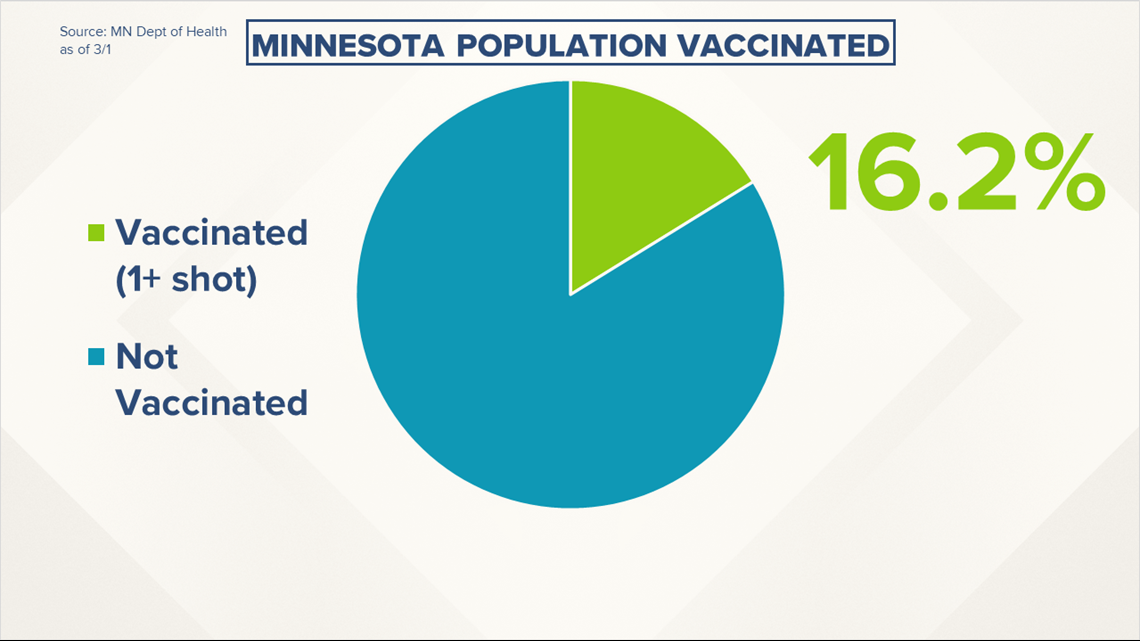
On Monday, MDH reported 636 new COVID-19 cases, based on 19,374 tests (18,208 PCR, 1,166 antigen) processed over the weekend. Testing volume was low, as it regularly is on Mondays. The new cases bring Minnesota's total since the start of the pandemic to 485,230, with 23,703 of those cases being documented with antigen tests.
Health experts consider a positive PCR test a confirmed COVID case, while a positive antigen test is considered probable.


Three more deaths to COVID were documented, bringing total of fatalities in the state to 6,486. Of those deaths 4,057, or 62% of them, are tied to long-term care or assisted living settings.
As of Sunday, 230 people were being treated for coronavirus in hospitals across the state, with 47 of them requiring ICU care. Availability of non-ICU beds is up slightly across the Twin Cities metro, with an open bed rate of 3.6% (133 open).
Total hospitalizations since the onset of the pandemic have climbed to 25,727, with 5,308 of those patients being treated in the ICU.
Of those who have tested positive for COVID-19, 471,647 people have passed the point where they are required to isolate.
Young adults between the ages of 20 and 24 comprise the largest group of Minnesota's COVID cases, with 48,296 and three deaths, while those 25 to 29 are linked to 43,349 and six deaths. The population hit with the most coronavirus-related fatalities are people 85 to 89, with 1,229 deaths in just 6,248 diagnosed cases.


Hennepin County has recorded the most COVID activity in the state with 100,680 cases and 1,585 deaths, followed by Ramsey County with 43,047 cases and 801 deaths, Dakota County with 36,254 cases and 390 deaths, and Anoka County with 33,274 cases and 384 fatalities.
Cook County in northeast Minnesota reports the least COVID activity with 118 cases since the pandemic began.


